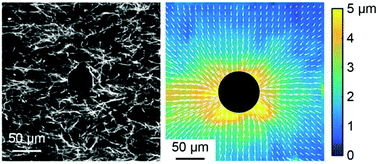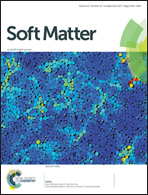Mechanical response of collagen networks to nonuniform microscale loads†
Abstract
As force is applied to fibrous proteins such as collagen or fibrin, the fibers respond by bending, stretching, or buckling, which together bring about a nonlinear relationship between force and displacement. The nonlinearity is typically understood in terms of strain stiffening in uniform extension or shear, but there remains a critical lack of data on how fibrous materials respond to other more complicated loadings. Here we study the mechanics of collagen networks in response to nonuniform loads applied on the local scale of the fibers. For this, we use particles made of an active hydrogel that undergoes a temperature-induced phase transition causing a large decrease in volume. We embed these particles in networks of fibrous collagen and use them as microactuators to apply controlled microscale loading. The resulting fiber displacements propagate over a long range with radial displacements u scaling as r−n with n ≈ 1. By contrast, we find linear homogeneous materials have n ≈ 2, in agreement with classical linear elastic theory. Our experimental data supports the notion that the long range displacements result from buckling of fibers in compression and local straightening of fibers in tension, in agreement with previous studies. Surprisingly, global network anisotropy appears to have only a modest effect on the displacement propagation. These insights into the microscale mechanics demonstrate that the decay power n provides a useful metric to quantify the mechanics of fibrous materials. We therefore suggest it is a means to compare new theories with experimental data.



 Please wait while we load your content...
Please wait while we load your content...